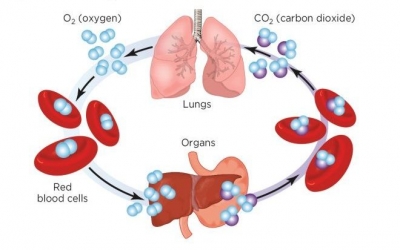
Air first enters the body through the mouth or nose, quickly moves to the pharynx (throat), passes through the larynx (voice box), enters the trachea, which branches into a left and right bronchus within the lungs and further divides into smaller and smaller branches called bronchioles. The smallest bronchioles end in tiny air sacs, called alveoli, which inflate during inhalation, and deflate during exhalation.
The body’s cells need to receive a continual supply of oxygen, while getting rid of their waste carbon dioxide. This swapping of gases is called gas exchange.
The walls of the alveoli actually share a membrane with the capillaries in which oxygen and carbon dioxide move freely between the respiratory system and the bloodstream. Oxygen molecules attach to red blood cells, which travel back to the heart. At the same time, the carbon dioxide molecules in the alveoli are blown out of the body with the next exhalation.
Picture Credit : Google

